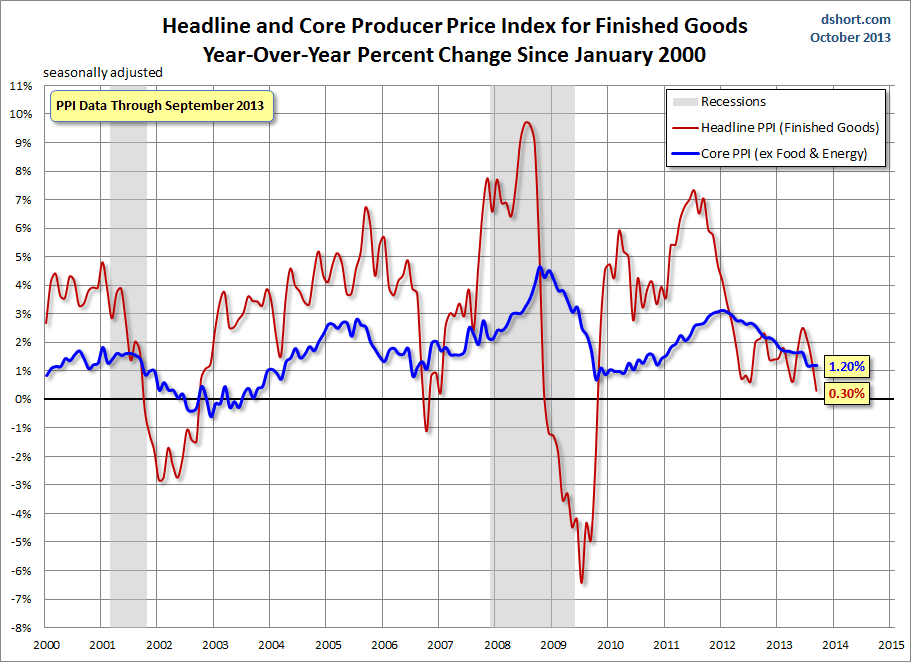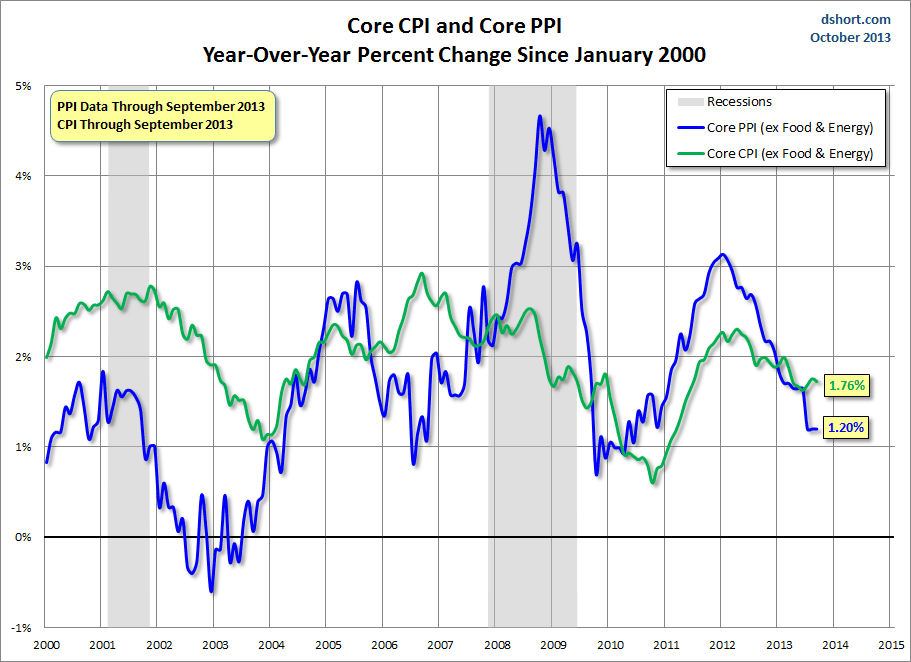Note from dshort: I was still in vacation mode when the Producer Price Index was released Tuesday. In response to a couple of email requests, I've posted a late update (although certainly less tardy than shutdown-delayed report itself).
Tuesday's release of the September Producer Price Index (PPI) for finished goods declined -0.1% month-over-month, seasonally adjusted, in Headline inflation Investing.com had posted a MoM consensus forecast of 0.2%. Core PPI rose 0.1% from last month, which matched the Investing.com forecast.
Year-over-year Headline PPI is up only 0.30%, a drop down from last month's 1.38%. The 1.20% Core PPI, unchanged from the past two months, remains at its lowest YoY since June 2010.
Here is the essence of the news release on Finished Goods:
In September, the 0.1-percent decline in the finished goods index is attributable to prices for finished consumer foods, which fell 1.0 percent. By contrast, the indexes for finished energy goods and for finished goods less foods and energy moved up 0.5 percent and 0.1 percent, respectively.
Finished foods: Prices for finished consumer foods fell 1.0 percent in September, the largest decline since a 1.0-percent decrease in April 2013. A 17.9-percent drop in the index for fresh and dry vegetables accounted for two-thirds of the September decline. Lower prices for carbonated soft drinks and processed poultry also contributed to the decrease in the finished consumer foods index. (See table 2.)
Finished energy: The index for finished energy goods advanced 0.5 percent in September following a 0.8-percent rise in August. One-third of the September increase is attributable to a 6.0-percent jump in the index for home heating oil. Higher prices for residential natural gas also were a factor in the advance in the index for finished energy goods.
Finished core: The index for finished goods less foods and energy inched up 0.1 percent in September after no change in the prior month. A 0.6-percent increase in prices for motor vehicles led the advance in the finished core index. More...
Now let's visualize the numbers with an overlay of the Headline and Core (ex food and energy) PPI for finished goods since 2000, seasonally adjusted. As we can see, the YoY trend in Core PPI (the blue line) declined significantly during 2009 and stabilized in 2010, increase in 2011 and then began falling in 2012. Now, as we move toward the last quarter of 2013, the YoY rate is about the same as in mid-2010. The more volatile Headline number is the lowest since the early months of the recovery from the Great Recession. 
As the next chart shows, the Core Producer Price Index is more volatile than the Core Consumer Price Index. For example, during the last recession producers were unable to pass cost increases to the consumer. Likewise in 2010 the Core PPI generally rose while Core CPI generally fell. Since 2012, Core PPI has steadily trended downward, and since January of this year, Core PPI trended below Core CPI..
Check back next month for a new update.
- English (UK)
- English (India)
- English (Canada)
- English (Australia)
- English (South Africa)
- English (Philippines)
- English (Nigeria)
- Deutsch
- Español (España)
- Español (México)
- Français
- Italiano
- Nederlands
- Português (Portugal)
- Polski
- Português (Brasil)
- Русский
- Türkçe
- العربية
- Ελληνικά
- Svenska
- Suomi
- עברית
- 日本語
- 한국어
- 简体中文
- 繁體中文
- Bahasa Indonesia
- Bahasa Melayu
- ไทย
- Tiếng Việt
- हिंदी
Producer Price Index: YoY Headline Inflation Is Down, Core Unchanged
Published 10/31/2013, 12:25 AM
Updated 07/09/2023, 06:31 AM
Producer Price Index: YoY Headline Inflation Is Down, Core Unchanged
Latest comments
Loading next article…
Install Our App
Risk Disclosure: Trading in financial instruments and/or cryptocurrencies involves high risks including the risk of losing some, or all, of your investment amount, and may not be suitable for all investors. Prices of cryptocurrencies are extremely volatile and may be affected by external factors such as financial, regulatory or political events. Trading on margin increases the financial risks.
Before deciding to trade in financial instrument or cryptocurrencies you should be fully informed of the risks and costs associated with trading the financial markets, carefully consider your investment objectives, level of experience, and risk appetite, and seek professional advice where needed.
Fusion Media would like to remind you that the data contained in this website is not necessarily real-time nor accurate. The data and prices on the website are not necessarily provided by any market or exchange, but may be provided by market makers, and so prices may not be accurate and may differ from the actual price at any given market, meaning prices are indicative and not appropriate for trading purposes. Fusion Media and any provider of the data contained in this website will not accept liability for any loss or damage as a result of your trading, or your reliance on the information contained within this website.
It is prohibited to use, store, reproduce, display, modify, transmit or distribute the data contained in this website without the explicit prior written permission of Fusion Media and/or the data provider. All intellectual property rights are reserved by the providers and/or the exchange providing the data contained in this website.
Fusion Media may be compensated by the advertisers that appear on the website, based on your interaction with the advertisements or advertisers.
Before deciding to trade in financial instrument or cryptocurrencies you should be fully informed of the risks and costs associated with trading the financial markets, carefully consider your investment objectives, level of experience, and risk appetite, and seek professional advice where needed.
Fusion Media would like to remind you that the data contained in this website is not necessarily real-time nor accurate. The data and prices on the website are not necessarily provided by any market or exchange, but may be provided by market makers, and so prices may not be accurate and may differ from the actual price at any given market, meaning prices are indicative and not appropriate for trading purposes. Fusion Media and any provider of the data contained in this website will not accept liability for any loss or damage as a result of your trading, or your reliance on the information contained within this website.
It is prohibited to use, store, reproduce, display, modify, transmit or distribute the data contained in this website without the explicit prior written permission of Fusion Media and/or the data provider. All intellectual property rights are reserved by the providers and/or the exchange providing the data contained in this website.
Fusion Media may be compensated by the advertisers that appear on the website, based on your interaction with the advertisements or advertisers.
© 2007-2025 - Fusion Media Limited. All Rights Reserved.
